
Dendrobium crumenatum, commonly called pigeon orchid, or 木石斛 is an epiphytic orchid in the family Orchidaceae and is native to Asia, Southeast Asia, New Guinea and Christmas Island. It has two rows on leaves along its pseudobulb and relatively large but short-lived, strongly scented white flowers. It usually grows in exposed positions in lowland rainforest and coastal scrub.

Hymenosporum is a monotypic genus of trees in the family Pittosporaceae. The sole included species is Hymenosporum flavum, commonly known as native frangipani, found in the rainforests and wet sclerophyll forests of New Guinea, Queensland and New South Wales. Despite its common name, it is not closely related to the frangipani, but is related to the widespread genus Pittosporum.

Buckinghamia is a genus of only two known species of trees, belonging to the plant family Proteaceae. They are endemic to the rainforests of the wet tropics region of north eastern Queensland, Australia. The ivory curl flower, B. celsissima, is the well known, popular and widely cultivated species in gardens and parks, in eastern and southern mainland Australia, and additionally as street trees north from about Brisbane. The second species, B. ferruginiflora, was only recently described in 1988.

Murraya paniculata, commonly known as orange jasmine, orange jessamine, china box or mock orange, is a species of shrub or small tree in the family Rutaceae and is native to South Asia, Southeast Asia and Australia. It has smooth bark, pinnate leaves with up to seven egg-shaped to elliptical leaflets, fragrant white or cream-coloured flowers and oval, orange-red berries containing hairy seeds.
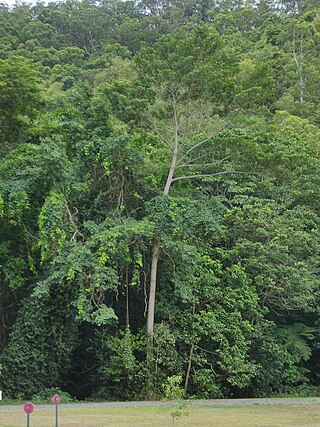
Elaeocarpus grandis, commonly known as the blue quandong, silver quandong or blue fig, is a species of flowering plant in the family Elaeocarpaceae which was first described in 1860. It is a large buttressed tree native to the coastal rainforests of northeastern Australia. The validity of this taxon is disputed, with some authorities accepting it and others presenting it as Elaeocarpus angustifolius.

Akania is a monotypic genus in the family Akaniaceae. The single species, Akania bidwillii (turnipwood), is a tree that is native to subtropical and warm-temperate coastal rainforests in New South Wales and Queensland in Australia. It is known locally as turnipwood because when it is cut down it gives off a foul odour similar to turnips. It blooms with white or pink, fragrant flowers in the spring, and the fruit is a dull-red round capsule that dries down and releases 1-2 seeds. Panicles usually 8–15 cm long; pedicels 5–20 mm long. Calyx 3–4 mm long. Corolla 8–12 mm long.

Stenocarpus salignus, known as the scrub beefwood is an Australian rainforest tree in the family Proteaceae. Found in warmer rainforests on the coast and ranges. It is often found in warm temperate rainforest on poorer sedimentary soils, or on volcanic soils above 750 metres above sea level. It was originally described by the botanist Robert Brown in 1810.

Polyosma cunninghamii, known as the featherwood, is a small rainforest tree of eastern Australia. It grows in many different types of rainforest, however seldom found in the drier rainforests. It is often seen in the cooler rainforests at high altitude. The range of natural distribution is from Kioloa near Batemans Bay in southern New South Wales, to Maleny in south eastern Queensland.

Clerodendrum tomentosum, known as the downy chance, hairy lolly bush, hairy clairy or hairy clerodendrum is a shrub or small tree occurring in eastern and northern Australia. It is distributed from Batemans Bay in southern coastal New South Wales, to Queensland, Northern Territory, Western Australia, and New Guinea.

Cyclophyllum longipetalum, known as the coast canthium is a shrub or tree occurring in eastern Australia. Commonly seen growing in a variety of different rainforest situations. It occurs from Lake Conjola in southern New South Wales to Fraser Island in southeastern Queensland.

Cinnamomum virens is a rainforest tree growing in the eastern coastal region of Australia. Common names include red-barked sassafras, black sassafras, camphorwood, scentless cinnamon wood, and native camphor laurel. Its habitat is between the Williams River and the Main Range National Park in Queensland. Growing in rich volcanic soils or on poorer sedimentary soils, it is often in association with coachwood.
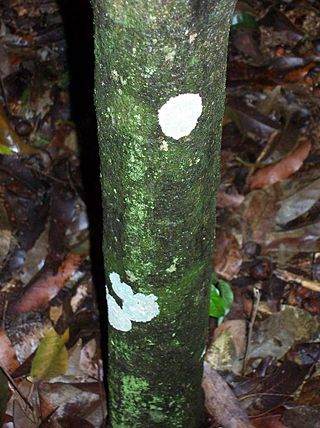
Ochrosia moorei, known as the southern ochrosia is a rainforest plant of eastern Australia. Endangered by extinction, it has a ROTAP rating of 2ECi.

Hoya aldrichii, commonly known as the Christmas Island waxvine, is a species of flowering plant in the Apocynaceae or dogbane family. It is a vine that is endemic to Christmas Island, an Australian territory in the north-eastern Indian Ocean, where it is a common epiphyte in the shrublands of the island's coastal terraces. The specific epithet honours Captain Aldrich, commander of the survey vessel HMS Egeria, which visited Christmas Island in 1887.
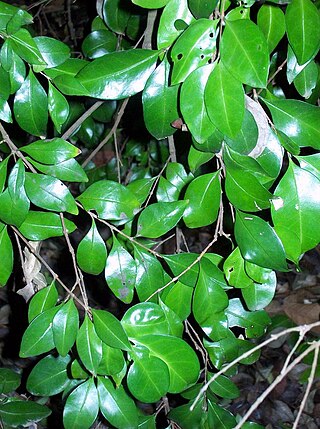
Gossia fragrantissima, the sweet myrtle or small-leaved myrtle, is a shrub or small tree of eastern Australia. A plant with a ROTAP rating of 3EC-, endangered by extinction. Found in sub tropical rainforests near streams, from near Woodburn, New South Wales to Nambour in south eastern Queensland. It features fragrant flowers, hence the specific epithet fragrantissima. White flowers grow from October to February.
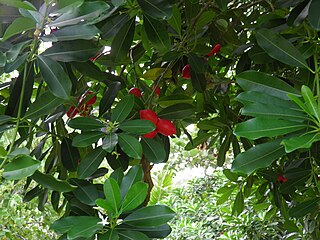
Ochrosia elliptica, commonly known as northern ochrosia, bloodhorn, scarlet wedge-apple, or simply ochrosia, is a tree in the dogbane family Apocynaceae native to north-eastern Australia and the southwest Pacific.
Habenaria hymenophylla, commonly known as the coastal rein orchid, is a species of orchid that is endemic to northern Australia. It has up to eight leaves scattered along the stem and up to thirty fragrant green and white flowers.
Dendrobium maidenianum, commonly known as the coastal burr orchid, is an epiphytic or lithophytic orchid in the family Orchidaceae and is endemic to tropical North Queensland, Australia. It has a single thin, dark green leaf on a thin stem and one or two small white flowers that self-pollinate. It grows on trees and rocks in shady rainforest.
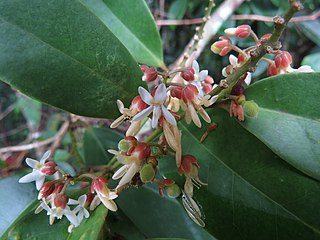
Xanthophyllum octandrum, commonly known as Macintyre's boxwood, false jitta, yellow boxwood or sovereignwood, is a slow-growing tree in the milkwort family Polygalaceae which has the potential to reach thousands of years of age. It is endemic to coastal northeastern Queensland, Australia.

Fagraea fagraeacea, commonly known as yellowheart or pink jitta, is a plant in the gentian family Gentianaceae which is native to New Guinea and Queensland.
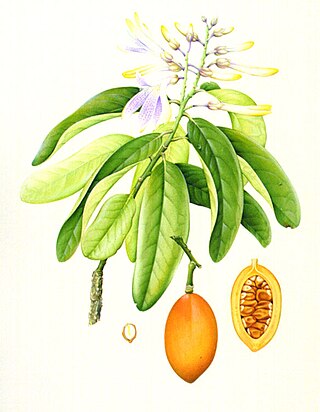
Xanthophyllum fragrans, commonly known as fragrant boxwood, is an evergreen plant in the family Polygalaceae found only in the Wet Tropics bioregion of Queensland, Australia.


















